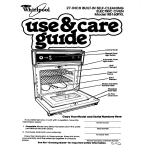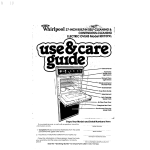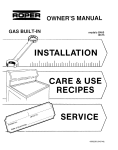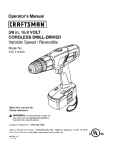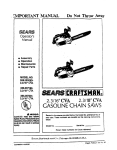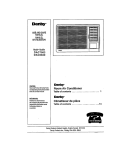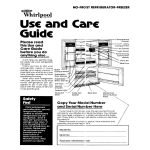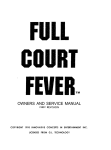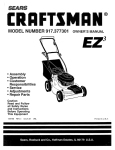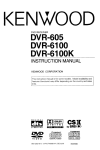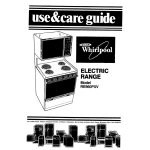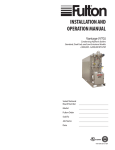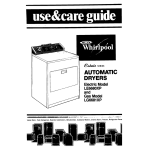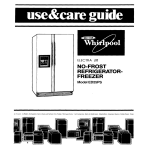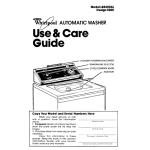Download Maytag 4348178 Installation guide
Transcript
ELECTRIC BUILT-IN DOUBLE OVEN USE AND CARE MANUAL Copy Your Model and Serial Numbers 1 3 IN THE BOX BELOVJ Model and Serial numbers are on a plate, behind the oven door, on the front frame. If you call for service, or with a question, have this information ready. Keep this book, your installation guide, your warranty and the sales slip together. Model No.: Serial No. : Purchase Date: I i PART NO. 4348178 (336326) SAFETY RULES HOW TO USE YOUR OVEN l l l l . l l l l l ......... Clock and Oven Controls .................. Oven Light .............................. Oven Vent ............................... New Oven Odor ......................... Preheating .............................. COOKING l .3,4 ................... HINTS .5-7 .5,6 . 7 .7 ,7 . . . . . . . . . . . . . . . . . 8-10 Rack and Pan Arrangement Using Foil Broiling Tips Positioning Broiler Pan Choosing Oven Cookware Common Baking Problems and Causes 8 8 9 9 10 10 CLEANING l . . l . . l AND CARE ............ . l l-15 Oven Cleaning .... .11,12 ................... Cleaning Chart ........... ,13 ... ........ Removable Oven Doors .14 ........ ....... 15 Removable Oven Racks ................... Replacing the Oven Light .................. .16 Removable Oven Control Knob ..... .... .16 Adjusting Oven Temperature .... .17 ........ PREVENTING SERVICE CALLS ....... .18 IMPORTANT INSTRUCTIONS Read the Safety Rules below and all operating before using this appliance. Never heat unopened Keep this manual for later use. Be sure your oven is installed instructions build-up injury. and grounded properly. food containers. Pressure may make container burst and cause Never try to fix or replace any part of the oven Never wear loose clothing while using your oven. Such clothes could catch fire. unless this book tells you to. All other work should be done by a skilled technician. Always use care when opening Never block free airflow through See page 7. Always move oven racks while oven is cool. oven door. Let hot air or steam out before moving food. the oven vent. Teach your children not to play with oven knobs or any other part of the range. Never let children sit or stand on the open oven door. Always use dry pot holders when removing pans from the oven. Moist or damp pot holders can cause steam burns. Do not use a towel or other bulky cloth. It may catch fire on the element. Never leave children alone or unwatched where an oven IS in use. Children should never be allowed to sit or stand on the open oven door. Teach children Never try to move a pan of hot fat, especially deep fat fryer. Wait until the fat has cooled. a Always keep the oven area clear and free from things that will burn, gasoline and other flammable vapors and liquids. Never store things in an oven. These things may catch fire and plastic items may melt and burn. not to play with oven controls. Never use your oven for warming or heating a room. Such use can be dangerous and hurt oven parts. 3 g c u, Never touch oven heating elements or Interior surfaces of oven. Heating elements and nearby areas may be hot enough to burn you even though they are dark in color. During and after use, do not let clothing or flammable materials touch heating elements or oven surfaces until they have had time to cool. Other surfaces that may become hot during use are the oven vent duct and the oven door. When broiling, always take the broiler pan out of the range and clean it when you are finished cooking. If you forget that a broiler pan was left in the range and later turn on the oven, you may start a fire. SELF-CLEANING OVEN ONLY Always take the oven racks, the broiler pan and other pots and pans out of the oven before a self clean cycle. Never use any kind of oven cleaner or oven liner coating. Do not use any spray cans near your oven. The gas used to make these cans spray can make metal parts rust in areas of high heat. The door gasket is needed for a good seal so care should be taken not to rub or move the gasket. Clean with hydrogen peroxide. See page 11. Always follow cleaning Never use aluminum foil to line oven bottoms. Only use foil as shown on page 9 of this book. Improper use of foil could start a fire. instructions on pages 11 and 12 of this book. Never try to clean other things in the oven during a self clean cycle unless this book tells you to. UPPER OVEN The upper oven IS operated through the Electronic Oven Control (shown above) You can bake or broil In the upper oven. You can also program bake times Into the Electronic Oven Control (see To Use Tlmed Oven/Delay Start). TO BAKE: 1 TO SET THE CLOCK 1. Push Ihe CLOCK button. 2 Turn SET knob to correct time of day. Clock IS now set. 2. Turn SET knob until desired temperature is displayed. The oven beglns to heat within two seconds, and the display will show the temperature as it rises (in 5OF steps). 3. Note: To display the time of day during timed baking, push the CLOCK button. This WIII show the time but will not cancel any oven operation. 4. TO SET THE TIMER: 1 2. Push TIMER button. Turn SET knob to desired amount of time. The Timer will immediately begln to count down. 3 When time IS up, the end of cycle tone will sound. 4 To cancel Ihe Timer, push and hold TIMER button for three seconds. This WIII clear the TIMER function. If the “Timer time” was being dlsplayed, the d&play will go to the time of day. If the “Timer lime” was not being displayed, the display will not change. Push BAKE button. The Notificaflon Tone will sound when the oven has stabilized ar the selected lemperature. The display will show this temperature before the tone. When finlshed baking, push Ihe OVEN CANCEL button. Note: To recall what lemperature you have selected while the rising temperature is being shown, push and hold the BAKE button The selected temperature will be shown while you hold the BAKE button and will return lo actual oven temperature when you release the BAKE button. You can change the selected temperature at any time by pushing the BAKE button and turning the SET knob. TO BROIL: Note: The Timer IS a reminder only and will not operate the oven. You can use the Timer whether or not the oven is being used. The Timer does not interfere with oven operatlons. 5 1. Push BROIL button. 2. Turn SET knob until HI or LO Broil is visible 3. When finished broiling, push Ihe OVEN CANCEL button. in Lhe display (see page 9). TO USE TIMED OVEN/DELAY START Put the food in the oven and program your Electronrc Range Control to turn the oven on and off. Follow instructions below Push BAKE button. 6. Set desired temperature wrth SET knob. 7. When STOP TIME is reached, the end of cycle tone will sound and the oven will lurn off. Note: You can push the STOP TIME button to find out when the oven will turn off. Push and hold the COOK TIME button to find out when the oven will turn on. CAUTION Never let food sit for more than 4 hours before cooking starts, when you set your oven for a delay start. Room temperature is ideal for the growth of harmful bacteria. Be sure oven light growth. Note: To cancel any timed oven operation, 5. When a function has been entered, you can recall what has been programmed by pushing the corresponding functron button. The messages in the display show you which function is currently being displayed. While the function is displayed, you can change it with the SET knob. You can change any programmed function at any time. push the CANCEL button. Never slide the door IocWunlock handle into the LOCK position while trying to bake or brorl. You will not be able to program your oven to bake or broil if the oven door is locked. If you try to lock the door while the oven is on, the oven will turn off immediately. TO START NOW AND STOP LATER: 1. Push COOK TIME button. Set length of baking time wilh SET knob. LOWER OVEN 3. Push BAKE button. 4. Set desired temperature with SET button. The lower oven is operated through the Lower Oven control located on the left side of the control panel. You can use the lower oven while the upper oven IS berng used. You cannot broil in the lower oven. 5. When COOK TIME is reached, the end of cycle tone will sound and the oven will turn off. 2. TO BAKE: 1, Turn Lower Oven Control to desired temperature. 2. When frnished turn Lower Oven Control to OFF. TO START LATER AND STOP LATER: 1. Push COOK TIME button. LOWER OVEN SIGNAL LIGHT 2. Set length of baktng time with SET knob. 3. Push STOP TIME button. 4 Set time of day when baking should be completed with SET knob The oven srgnal llghl will glow when the Lower Oven control IS turned on and the oven IS heatrng. When the set temperature IS reached, the light will go out and then cycle on and off to show the temperature is being maintained 6 OVEN LIGHT TONES The oven light switch is located on the left side of the control panel. See page 16 for more information. End of Cycle Tone (3 long beeps one second on, one second off): shows that a timed oven operation has reached STOP TIME or that the Timer has counted down. OVEN VENT Attention Tone (senes of short beeps, one quarter second on, one quarter second off, until proper response is given): will sound if oven has only been partially programmed. Fox example, if you have selected a COOK TIME but no temperature, you WIIIhear the attention tone until you select a temperature or push OVEN CANCEL. Notification Tone (single, one second beep): shows that the oven has stabilized at the selected temperature. The vent area could get hot during oven use. ii The vent is needed for proper air flow in the oven and good baking results. Do not block this vent. Doing so may cause cooking failure, fire or damage to the oven. d NEW OVEN ODOR G During the first baking and broiling cycles of your new oven, there may be some odor. This is normal and is caused by the heating of new parts and insulation. The odor will go away within a short time. A vent fan or other ventilation will help to clear the way. Keytone (single, one tenth second beep): sounds when any button is pusheo. PREHEATING Failure Tone (senes of very rapid beeps, one eighth second on, one quarter second off). display will show FO-FE. Cancel failure tone by pushing the OVEN CANCEL button. If the fallure occured while you were programming the Eiectnc Range Control, push the OVEN CANCEL button and try agaln If you still get a failure tone that does no1 stop after 16 seconds, call for service If you are unable IO cancel the failure tone with the OVEN CANCEL. button. unplug the range or disconnect the clrcult breaker If you prefer that your range not have an audible tone at the end of a cycle or when you push a button (Key Tone), you can eliminate the End of Cycle and Key Tone by pushing and holding the OVEN CANCEL button untll you hear a short beep (In approximately two seconds) If you wish to activate the tones again. push and hold the OVEN CANCEL button once more until you hear a shorl beep Cancellmg or actlvatlng the tones should only be done when there IC no oven operation programmed Pushing the 3VEN CANCEL b&on WII clear all functions except the clock and Timer 2 When the oven is on, heated air moves through a vent below the control panel. Preheating lets the oven heat evenly before the food is put in. Allow 10 minutes at temperature less than 35oOF and about 15 minutes at temperatures of 35oOF or more. With recipes that call for an oven preheated to a certain temperature. It is very important that you follow those instructions. It is not likely that you WIIIget good baking results every time without preheating to the needed temperature unless the recipe says to start In a cold oven. After the oven is preheated and you are ready to put the food in, try to have everything handy so that you will not have to leave the oven door open for an extended period of time. Opening the door to check the food during baking makes it impossible for the oven to stay at the temperature you have selected. Try to time your baking and check only when close to being finished. 7 NOTE: When using cookware made of ovenproof glass or pottery, Teflon coated cookware or dull or darkened pans in the oven, be sure to reduce recipe temperature by 25oF (see Choosing Cookware Chart, page 10). USING FOIL RACK AND PAN ARRANGEMENT Put oven rack(s) rn place before turnrng on the oven. Rack posttrons are numbered 1 to 4, starting al the bottom of number 1. In general, when usfng only one rack, posrtron No 2 should be used. When ustng two racks, posftrons No. 2 and 4 work best When using cookre sheets, place them wfth the long side toward the front of the oven and centered on the rack. When using two cookie sheets at the same time use rack positions No. 2 and 4. The cookies on the lower rack may be done 1-2 mrnutes before the ones on the higher rack. You may want to swatch rack positions when baking is halfway finished. Pans too close to each other, to oven walls or to the oven bottom block the free movement of air improper air movement causes uneven brownIng and cooklng. Normally lhere should be 1% to 2 inches of air space on all sides of each pan In the oven, See tips below When baking a sponge or angel ‘ood cake center on one rack in the one rack For Baking To catch spillovers, cut a piece of foil slightly larger than the pan and turn up the edges. use two oven racks and put the foil on the lower oven rack below the pan. Do not use aluminum foil directly under a pan on the same oven rack. The foil will not reflect heat away from the pan. A Do not cover the oven bottom or an entire oven rack with foil. The foil can block normal heat flow, cause cooking failures, and damage the oven interior. For Roasting For slow browning, place a fofl “tent” loosely over the meat. This ISespeciafly good on a large turkey. The “tent” lets oven heat cfrculate under the forl. Sealing the fool will tend to steam the meat. To reduce spattering, under the food Sheer Cakes, Cooktes. BlsculIs The pan or pans usrng Ihe leas1 amount of rack area should be f$Ed on the lower of the two Cake Layers Pies Casseroles, 3 pans lrghtly crush forI and put It In the bottom of the pan Angel Food or Sponge Cake When using Iwo racks and several pans, stagger them so an IS drrectly above no anot i er, , Cake Layers, Pies 4 Pans (staggered) For Broiling A Do not cover the entire broiler grid with foil. Poor drainage of hot fat may cause a broiler fire. If a fire starts, close the oven door and turn controls off. If fire continues, throw baking soda on the fire. Do not put water or flour on the fire. Flour may be explosive. Most foods can be broled on the HI settrng Select fhe LO brorl senlng lo avoid excessive browning or dr 1ng of foods thal should be cooked to the well done stage (such as thlc I pork chops or poultry) The closer the lood !s to the broil element the faster the meal browns on the outslde yet slays red to pink in the cenler Moving Ihe meal farther away from the elemenl lets the meal cook to Ihe center while brown’ng oufstde BROILING TIPS Your oven door should be open to the stop position whfle broiling (See page 14). If the door IS closed, the food WIII roast and not broil Use only !he broiler pan and grid lurnlshed with your range for broil lng They are desIgnad for proper dralnage of fal and lrqurds and help prevent spatter smoke or I~re Do not preheal when brollliTg For even broiling oil both sides slarf Ihe food on a cold pan Allow slightly more lhan half the cooking time for the 11~1side then lurn the load using tongs II you pierce Ihe meat with a lark, the lulces WIII escape : When brorltng frozen meats, use one rack posItIon lower than recomb mended up lo 1% times the suggested brolllng time Tnm the outer layer of fat from steaks and chops Slrf fhe fatfy edges to keep the meat from curlkng Always put the food betng brotied on the proper rack (see chart al rrght). Food placed too close lo the broiler may spatter, smoke or catch fire For maxrmum jurcrness, salt the frrst srde lust before turnrng the meat Salt the second srde fust before serving Brush chrcken and fish with butter several times as they broil. When broiling fish, grease the grid lo prevent sticking and broil with skin side down. It is not necessary to turn fish, Never leave a soiled broiler pan in the ran e. Grease In the pan may smoke or ignite the next time oven in use 2 See page 13 for tips on cleaning the broiler pan and grid. POSITIONING Food Rack Poslllon 4 = Highest 1 = Lowest i TolaI Times (Minutes) Steak 1 Thick Rare Medium Well Done 4 3 3 9-l 1 13-15 21-23 Ground Beef Pattres Medium 1” Thick Medium ‘/z” Thrck 3 A 16.18 7.9 - BROILER PAN (upper oven only) Bacon Brorlrn IS cookrng by drrect heal from the upper oven element Tender cuts o Pmeat or marinated meal should be selected for brolllng For best results steaks and chops should be at !easl 31”’ thrck After placrng food on the brofler pan, put the pan on an oven rack In the roper posrtron The recommended rack posrlron and cookrng trme can Ee found In the chart at right.. This chart is a general guide. The size, weight, thickness and starting temperature of the food, as well as your own personal preference. will affect the cook time. 9 OVEN COOKWARE Absorbs heat fasler than glass or steel and conducts heat well. Produces delicate brownmg. lender crust. and reduces spattering of roasts. Besl for cakes, muffins, quick breads, cookies, and roasting. Aluminum Ovenproof Pottery Darkened Glass/ Cookware Because this cookware absorbs heal quickly and holds il well, you should lower your oven temperature food a deep, crusty brown lop. Best for casseroles. Absorbs heat qurcker than shiny cookware. and other foods baked in pastry shells. Lower your oven temperature COMMON BAKING PROBLEMS AND CAUSES s 20 25oF (except for pastry). Good for pies BOTTOM PIE CRUST SOGGY 9 Frllrng too JUICY l Frllrng allowed lo stand In pre shell before baking l Used shrny pans l Temperature too low at start of baking l Crust and/or frllrng not allowed to cool before frllrng crust BURNING AROUND EDGES OF PIE CRUST l Oven lemperalures too high l Edges of crust loo thin or too high l Oven too full or pans loo close together COOKIES AND BISCUITS BURN ON BOl-fOM l Oven preheat lrme loo shon l Pan loo deep or loo large l Used dark pans l Used rncorrecl rack posrlron FOOD NOT DONE AT END OF COOKING TIME l Oven temperature set too low l Oven loo crowded l Oven door opened too often l Alumrnum forI blockrng arr movement CAKE RISES UNEVENLY l Range or oven rack not level l Pan warped l Batter spread unevenly rn pan l Pans too close to oven wall or rack loo crowded CAKE HIGH IN MIDDLE l Too much flour l Oven temperature too hrgh CAKE NOT DONE IN CENTER l Wrong srze pan l Oven loo hot l Pan no1 centered rn oven 5 I 25oF. Gives CAKE l Too FALLS much shortening, lrquld or sugar l Temperature loo low l Pan loo small l Oven door opened too often l Too much leavening or stale leavenrng Overmrxrng after addrng flour % 10 THE SELF-CLEAN 1 2 CYCLE (upper oven only) Remove the broil pan and gnd, oven-racks. all ulensrls and any forI that may be rn the oven If oven racks are left rn the range during a clean cycle, they will darken, lose therr IrJster and become hard lo slide So11on the oven front frame, under the front edge of the cooktop the door loner oulsrde the door seal and the front edge of the oven cavrty (aboul 1” Into Ihe oven) will not be cleaned durnrng a clean cycle (see rllustratron below) Clean these areas by hand before slartrng a clean cycle Use detergent and hot waler wrlh a soap-filled sleel wool pad, then rrnse well wrth a vrnegar and water mrx-ture Thus WIII help prevent a brown resrdue from formtng when the oven IS heated Before A Clean Cycle 3 4 Wrpe up heavy sptllovers on the oven bollom Too much sort may cause smokrng dunng the clean cycle Clean the door seal by usrng a clean sponge to soak Ihe sorled area with hydrogen peroxrde Repeated soakrng may be needed depen,drng on the amount of so11 Frequent cleanrng wrll prevent excessrve so11burld up Do not rub the door seal excessrvely The lrberglass materral of the seal has an extremely low resrstance to abrasron Any cotton material especrally !rncludrng cononballs), can easel rub a hole rnto Ihe seal Do not use any cotton materrals to clean 1t: e seal An tnlacl and well frnrng oven door seal IS essentral lor energy ef’kcrent oven operalron and good bakrng results If you nottce the seal becoming worn, frayed or damaged In any way or 11II has become drsplaced on the door you should reolace Ihe seal mow -- DO NOT use commercral oven cleaners or oven protectors In or near lhe oven These products plus Ihe hrgh lremperalure 01 Ihe clean cycle may damaoe the porcelarn lrnrsh DO NOT clean glass ceramic cookware or any olher cookware In the oven during a self-clean cycle IMPORTANT INFORMATION All controls must be sel correctly for the clean cycle lo work property. To help you understand how the clean cycle works, Ihe slages of the cycle are noted below 1 The conlrols are set and Ihe door lock handle moved right rnlo the lock postron 2 The oven begrns lo heal 3 For your safety, when the locking temperature IS reached the oven door can not be opened (the word LOCK wrll be on rn the Electronrc Range Control dtsplay) 4 When Ihe 3r/z hour clean cycle IS over the oven begins lo cool 5 When the temperature has fallen below lockrng temperature (about 20-30 mrnutes after oven goes off at end of clean cycle) the door can be opened Afler a cleaning cycle, the oven door cannot be unlocked the word LOCK IS off In the Electromc Range Control display F- L 11 TO STOP A CLEAN CYCLE: TO SET A CLEAN CYCLE The self-cleaning cycle IS preprogramed for 3112hours. You can also set the electronrc oven control for a delayed start of the clean cycle. 1 2 Press the OVEN CANCEL button Walt until the oven has cooled below the lockrng temperature (20-30 mrnutes) and the word LOCK IS OH In the Electronrc Range Control jrsptay 3 Strde the door handle lett to unlock the door You WI/ no1 be able to unlock the oven unless the oven temperature IS at a sale tevet Never force the door lo&unlock handle WHEN A CLEAN CYCLE IS FINISHED 1 2 To self-clean: 1 Slrde the door lock handle lo the right You may need to press the door slrghlly lo gel it lo lock properly Never try lo force the door lock handle. Forcrng the handle may damage the door lockrng machantsm 2. Push CLEAN button, The oven begins lo heat wrthrn 2 seconds Note: You can find out when the clean cycle WIII be frnrshed by pushrng the STOP TIME button !! 9 u s Wart until the oven has cooled below lockrng lemperature (20-30 mrnutes) and the word LOCK IS oft rn the Electronrc Range Conlrol drsptay Sltde the door IocWhandle lefl to unlock the door. You wrll not be able lo unlock rhe oven unless the oven lemperalure ISal a sale level. Never force the door lock handle. Note: If the door does not unlock because Ihe temperature has not had trme lo drop to a safe level when you ftrst try lo open the door, be sure lo sltde the door lockfunlock handle back all the way lo the righl AFTER A CLEAN CYCLE To use delayed self-clean: 1 Push STOP TIME button 2 Turn SET knob lo trme of day when you wash cleanrng to be completed (must be more than 3% hours later than current lime of day). 3. Slide Iha door lock handle lo the right. You may need to press the door slightly to get if lo lock properly. Never try lo force the door lock handle. Forcing the handle may damage the door locking mechanism. 4 Push CLEAN bunon. Note: Dunng a delayed self-clean operation you can find ou1 when the oven turns on by pushing and holdrng the CLEAN button. After a clean cycle, you may nolrce some whrte ash rn the oven Just wrpe it up wrlh a damp cloth If whrte spots remain. remove them wrth a soap-filled steel wool pad Be sure lo rinse thoroughly wrth a vrnegar and waler mrxlure. These deposits are usually a salt resrdue lhat can not be removed by the clean cycle II Ihe oven IS not clean after one clean cycle, the cycle may be repealed P 12 PART CLEANING INSTRUCTIONS Control Panel Wash control panel wrlh soap and water. Do not use abrasrve cleaners. Cl;;3i$e Finishes: Glass (some doors) Wash wrlh soap and waler. A chrome cleaner may be used. Wash wrth a soapy damp cloth Remove stubborn soil wrlh a paste of baking soda and waler or ammonia and water. Do not use abrasive materials. Before using an all-purpose cleaner, check the label to be sure it is will for recommended glass-some Paint (some doors) Wash wrth soap and water, rrnse then dry wrth a paper lowel. Avoid cleaning powders or abrasives which may scratch the surface. Oven Finishes: Porcelain (lower oven) Wash with soap, water and a scouring pad. Soak slubborn stains with an ammonia soaked paper towel, or set a dish of ammonia water in the oven overnight to loosen s@. then rub with a sxuring pad. Rinse thoroughly. When usrng oven cleaners, follow package directrons and be sure that no traces of the oven cleaner remains in the oven. Traces of the cleaner could put stains on the finish when heated To make sure this does not happen give a final rinse of vinegar and water. Caution: Do not coat heatin element and thermostat bulb in upper part of oven). a ever use oven cleaner on outsi,de oven surfaces, alumrnum, chrome or baked enamel. Self-Cleaning (upper oven) Use soap, waler and a scouring pad for touch up cleanrng between self-cleanrng cycles and rinse thoroughly Avoid any contact with the oven door seal (see below). Avoid all oven cleaners. Oven Door Seal (self-cleaning ovens) Soak soiled area with hydrogen peroxide (see page 11). Oven Racks Remove from oven (see InstructIons on page 15) and wash at srnk wrth soap, water and a scouring pad. If oven -. Do not leave in oven to cool. If you soak rmmedrately, clean-up ~111be easrer. Remove pan from oven and remove fat and dnpprngs Spnnkle pan wrth detergent then cover wtth a wet cloth or paper towel and let soak - Brorler Pan and Grid 13 permanently damage glass. To help prevent a brown resrdue from formrng on the oven window the next time the oven IS heated, rinse the inside of the window with vinegar and waler, then dry. racks are left rn oven during a clean cycle, wrpe edges wrth vegetable 011so lhey slrde rn and out easier. Later wash In soap and waler using a scouring pad as necessary Both the pan and grad are drshwasher sale. REMOVABLE OVEN DOOR(S) (24” wide units) The oven door can be removed for cleaning. To remove: 1. Open the door to the stop positron (see rllustratron) 2 Grasp the door at each srde and lift up and off the hinges. See the cleaning chart on page 13. NOTE: When the door is removed and hinge arms are at stop position, do not bump or try to move the hinge arms. The hinges could snap back causing an injury to the hands or damage to the porcelain on the front of the range. Cover the hinges with toweling or empty towel rolls while working in the oven area. To replace: 1 Hold the door over the hinges with the slots at the bottom edge of the door lined up wrth the hrnges. The hinge arms must still be in the stop position, 2. Slide the door down onto the hinges as tar as it will go and close the door. REMOVABLE c 5 w s F .I 5 z 0 STOP POSITION OVEN DOOR(S) (27” wide units) The oven doors can be removed for cleaning. To remove: 1, Open the door to lhe brotl slop posrtron and grasp the door at each srde (see Illustration). 2 Lrft the door up a brt, then pull strarghl toward you. To replace: 1 Make sure that hrnge arms are rn posrtron B (brorl stop posltron) Note: If a hinge arm snaps into pqsition A, it must be moved back to position B before the door can be replaced. 2 Carefully Insert the hrnge arms through the openings In the front frame and push the door Into place while holdrng the door up. 3. When the bottom edge of the door IS flush agarnst the front frame, allow the door to settle Into place 14 REMOVABLE REMOVABLE OVEN RACKS AND GUIDES (24” wide units) Be sure not to scratch the oven finish when installing or removing oven racks. To install: 1 Put the pegs on the end of the rack guide Into the holes In the oven back. 2 Lock the front hook tn the slot In lhe oven side. 3 Set the rarsed back edge of the oven rack on a pair of rack guides so the hooks al the srdes of the rack run underneath the rack guides. 4. ,_ ’ ,’ ’ ,_ RACK’HOOK RACK BUMP z. 3 m ii P a C 6$ij To install: 1. Set the raised back edge of the rack on a parr of rack gufdes. 2. Push the rack In untrl you reach the bump in the rack guide. then lilt the front of the rack a bft and push the rack all the way in P To remove: 1. Pull the oven rack OUI, then up, In one molfon. 2. Lrft the front of the rack guide to unhook rt from the oven wall and pull out. See the cleaning Instructions on page 13. ,’ 0 c To Remove: 1. Pull Ihe oven rack out, then up. See the cleaning chart on page 13. Push the rack rn until you reach the bump In the rack, then lift the front of the rack a bft and push the rack all the way In. HOLES \ \ OVEN RACKS (27” wide units) Be careful not lo scratch the oven finish when installing or removing the oven rack. 15 REPLACING THE OVEN LIGHT (Some Models) Do not touch oven bulb when hot, wrth wet hands, or wipe oven light area with wet cloth Unplug or drsconnect the eleclncal supply to range before removing Never touch the electrically live metal collar on the bulb when replacing it. Electrical power must be shut off if you have to replace a broken bulb. UPPER SELF-CLEANING OVENS 1, Remove the three screws and lift OH the glass retarner, glass cover and gasket. 2. Replace the bulb with a 40 watt appliance bulb 3 Replace the gasket, glass cover and glass retatner. Tighten screws securely BULB SOCKET _---- LOWER NON-SELF-CLEANING OVENS: b Replace bulb with a 40 watt appliance bulb. REMOVABLE E -E 3. 2 z u 5 z z u NON-SELF-CLEANING LOWER OVEN CONTROL KNOB All control knobs may be removed for easy cleaning by pulling the knob straight off the stem. See the cleaning chart on page 13 Caution: Read these instructions carefully before replacing the knobs. Replacing the knobs improperly will damage the knobs and the spring clip on the stems. If this happens, the knobs will fit loosely. To correctly replace knobs: 1. Look al the stem. It has a groove In each side. The groove on one side has a spring ckp, Ihe other groove is clear (see illustration). 2. Check the inside 01 the knob and find the molded rib. I+&.& l-b I$& Replace the knob by litting the molded rib inside the knob into the clear groove on Ihe stem. 16 OVENS ADJUSTING OVEN TEMPERATURE 4 Hold the knob handle (A on Illustration) while turning the knob skirt (I3 on Illustration) in the desired dIrection As you turn you should be able to hear clrcks and feel notches or teeth Each click or notch IS 100 You can turn up to 5 clicks or notches in either dIrectIon 5 When 6 IMPORTANT Belore you replace the OVEN TEMP knob, carefully read the lnstrucllons lor replactng the knob (on page 16) Do not force The lemperature in your new over, has been set correctly at the lactory, so be sure !o follow the recipe temperatures and Ilmes the first few times you bake lr’ your new oven If yoo !hlnk Ihe oven should be hotter or cooler you can adjust it yourself To decide how much to change Ihe temperature set Ihe oven temperature 25oF higher or lower than the temperature in your recipe. then bake The results of this test should gave you an Idea 01 how much the temperature should be changed you reach the desired the knob onto the thermostat adjustment, retlghten both screws stem or you may damage it. To adjust upper oven temperature. 1 Push the BAKE 2 Select a temperature 3 Oulckly (wIthIn two seconds, belore the BAKE function energizes) push ana hold the BAKE button The display WIII go blank and then WII show the amount of degrees dlverence between the orIginal factory temperature seUlng and the current temperature setting If the oven temperature has never been adjusted the display will read 00 4 The temperature can be adjusled up to 35OF hotter or 35OF cooler, in 5oF steps A rn~~us sign (-) before the number means that the oven WIII be cooler by dlsplayed amounl of degrees 5 When you have made the desired adjustment, push the CLOCK button to go back to the time of day display or use your oven as you would normally Note: The sell-clean button between temperature 500°F and 5500F with the SET knob trv~tlnot be changed by above MAKES OVEN HOTTER IScrew Moved Toward Hotter) descrlb~ ed adtdstment To adjust lower oven temperature: 1 Turr- OVEN TEMP knob to OFF and remove the knob by pullrng strarght ofl 2 Look at the back of the knob The arrow pornttng lo the center of the screw lndlcates the orrgrnal factory setting. The knob can be adfusted up to 500 hotter or 500 cooler. In 100 Increments. upper 3 Use a screwdriver to loosen the two screws about 1 turn each MAKES OVEN COOLER IScrew Moved Toward Cooler) :7 IF YOU HAVE A PROBLEM OVEN/BROILER Save lime and money - l check this list before you call for service. To elfmfnate unnecessary service calls, first read all the instructions in this manual carefully. Then, 11you have a problem, always check thus list of common problems and posstble solutions before you call for servfce. If you do have a problem you can not fox yourself, call your authorized Dealer for help. ELECTRONIC l l l l l l Check l l l l OVEN IS BEEPING l See the section on tones on page 7 l l Check to be sure oven cord IS plugged Into outlet completely. Check for a blown fuse or tnpped circuit breaker. Check for power outage Is the Lower Oven Control turned on If tryfng to use lower oven? Electronic Oven Control not set correctly. See pages 5 and 6 l on new oven odor l l on page 7 l BROILING PROBLEMS l l l l Are you using a tested recipe from a reliable source? Are you following all the instructions In the recfpe. such as pan size, preheating, usrng all rngredfents called for7 Oven too crowded, or usfng wrong rack posrtlon. See pages 8 and 10 for tips. Electronrc Oven Control not set correctly. See pages 5 or 6 for step by step Instructtons. Usfng Improper cookware. See ties on page 10 Check the sectron on baking problems and causes on page 10 Check for power outage Check for loose or burned out bulb. See page rnstructrons Check for blown fuse or trapped cfrcurt breaker 16 for replacement UPPER OVEN WILL NOT SELF-CLEAN (Some Models) OVEN GIVES OFF AN ODOR See the sectron range from the last time you brorled be left In the range or smoking and tfme the oven is used. and grease can not dram correctly. OVEN LIGHT WILL NOT WORK (Some Models) OVEN DOES NOT WORK l SMOKING grease left in pan must not result the next used properly COOKING RESULTS ARE NOT WHAT YOU EXPECTED OVEN CONTROL DOES NOT WORK Check to be sure oven cord IS plugged Into outlet completely for a blown fuse or tripped circuft breaker. Check for power outage Check step by step operatrng lnstructlons on pages 5 or 6 Check for blown fuse or tripped cfrcuit breaker Brorler pan full of food. Dirty broiler a broiler ffre can Alumrnum foil not See page 8 Electronrc Oven Controls not set properly. Review step by step Ins lnstrucbons on page 12 If oven went through clean cycle but did not get clean, oven was Loo drrty and should be cleaned more often Heavy splllovers were not wiped before starting clean cycle See page 11 Lock handle not in correct positfon See page 12 UPPER OVEN DOOR WILL NOT UNLOCK AFTER SELFCLEAN CYCLE (Some Models) Electronic Range Control not set to Boll (see pages 5 or 6) Usrng wrong rack posrtion See chart on page 9 Aluminum foil not used properly and grease can not drawn correctly See page 8 You cannot brorl In lower oven. l 18 The oven has not cooled to the unlocking temperature The door can not be opened until the temperature drops to a safe level See pages 11 and 12


















